Roofing Companies Wonder Lake
Best Roofing Services in Wonder Lake
Get 3 FREE Roofing Contractor quotes for your project today! Compare profiles, reviews, accreditations, portfolio, etc... and choose the best deal.
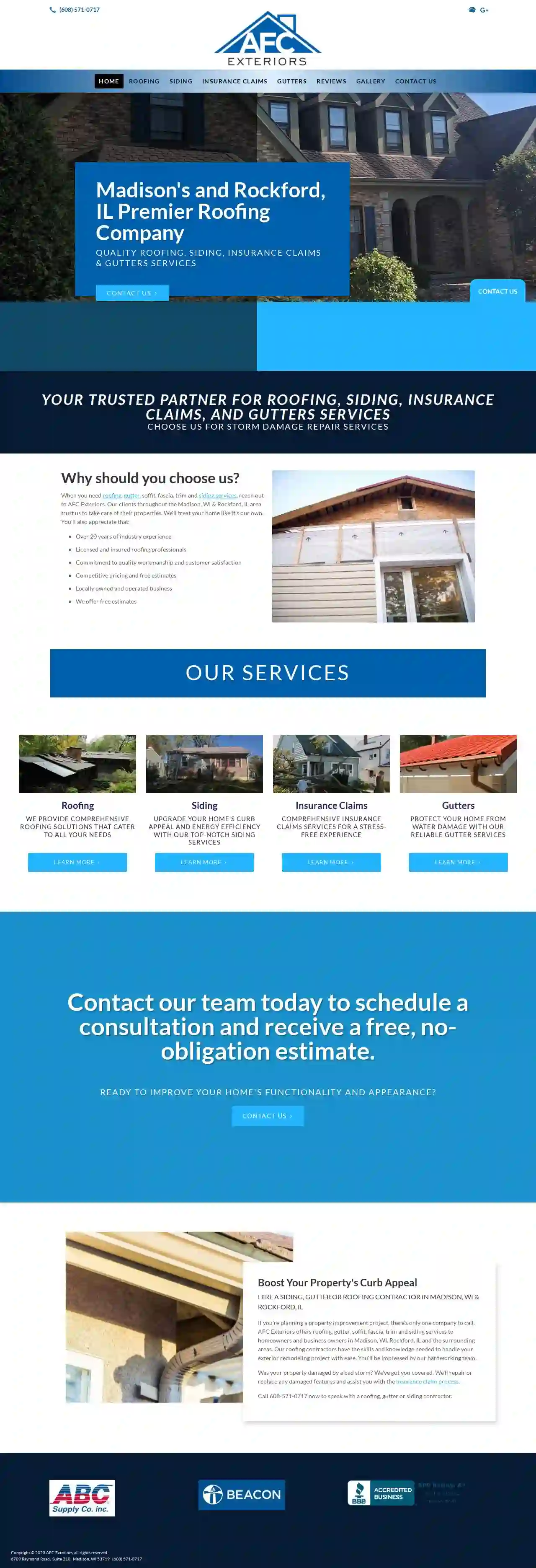
AFC EXTERIORS
Suite 210, Madison, 6709 Raymond Road, 53719, USAFC Exteriors is Madison, WI and Rockford, IL's premier roofing company, specializing in quality roofing, siding, insurance claims, and gutter services. With over 20 years of industry experience, our licensed and insured roofing professionals are committed to providing exceptional workmanship and customer satisfaction. We understand that your home is your sanctuary, and we treat every project with the utmost care and attention to detail. We offer free estimates and work closely with our clients to ensure their complete satisfaction. Whether you need a new roof, siding upgrade, insurance claim assistance, or gutter installation, AFC Exteriors is your trusted partner for all your exterior remodeling needs.
- Services
- Why Us?
- Accreditations
- Our Team
- Testimonials
- Gallery
Get Quote
Roof Maxx of Champaign, IL
54 reviewsChampaign, USRoof Maxx is a safe, easy, proven and affordable alternative to a complicated, expensive and life-disrupting asphalt roof replacement. We offer Military discounts and referral bonuses! I live in Urbana with my wife Emma, 10 year old daughter Anna, and our 3 dogs Nala, Lyanna, and Joe. We love to travel and stay active through scuba diving, paddle boarding, skiing, mountain biking, rock climbing, hiking, as well as more traditional sports like basketball, soccer, and football. We are big Illini fans and love being involved in the local community. I had a friend that introduced me to the company, and the more I researched the more I loved the idea of it. I loved the idea of giving people an option other than a costly roof replacement, I loved the idea of helping people save money, and I loved the opportunity to have my own business with the support that Roof Maxx Corporate provides. The product is incredible and does exactly what it is designed to do, and I am excited as we introduce it to the central Illinois market! I believe there's a genuine need in this market for a trustworthy roofing company. Customer service in the roofing industry in this region is seriously lacking, and it shouldn't be a challenge for a contractor to respond promptly to their customers. I'm passionate about educating people on the benefits of this product, empowering them with the information they need to make the best choices for their homes. Roof Maxx of Champaign, the whole family. We serve Champaign, Urbana, Decatur, Danville, Charleston, Mattoon, Effingham and surrounding areas. Contact Bradley at (217) 851-4959 or [email protected]. "Try not to become a person of success, but rather try to become a person of value."
- Services
- Why Us?
- Our Team
- Testimonials
- Gallery
Get Quote
Martin Exteriors Roofing & Siding
4.845 reviewsRoscoe, IL, 11704 Main Street, 61073, USMartin Exteriors Roofing & Siding is a leading and most reliable roofing contractor in Rockford IL regarding both craftsmanship and service. We are committed to quality, customer service, and efficiency. Our experienced project managers ensure that your roofing project will go smoothly from start to finish. We put great emphasis on professionalism and maintain the highest industry standards throughout our company and all our work. We make sure that both our clients and our workers are always fully protected by following all the necessary safety measures and procedures. Training, experience, and commitment to quality are what makes us your #1 trusted roofing contractor in Rockford IL.
- Services
- Why Us?
- Testimonials
- Gallery
Get Quote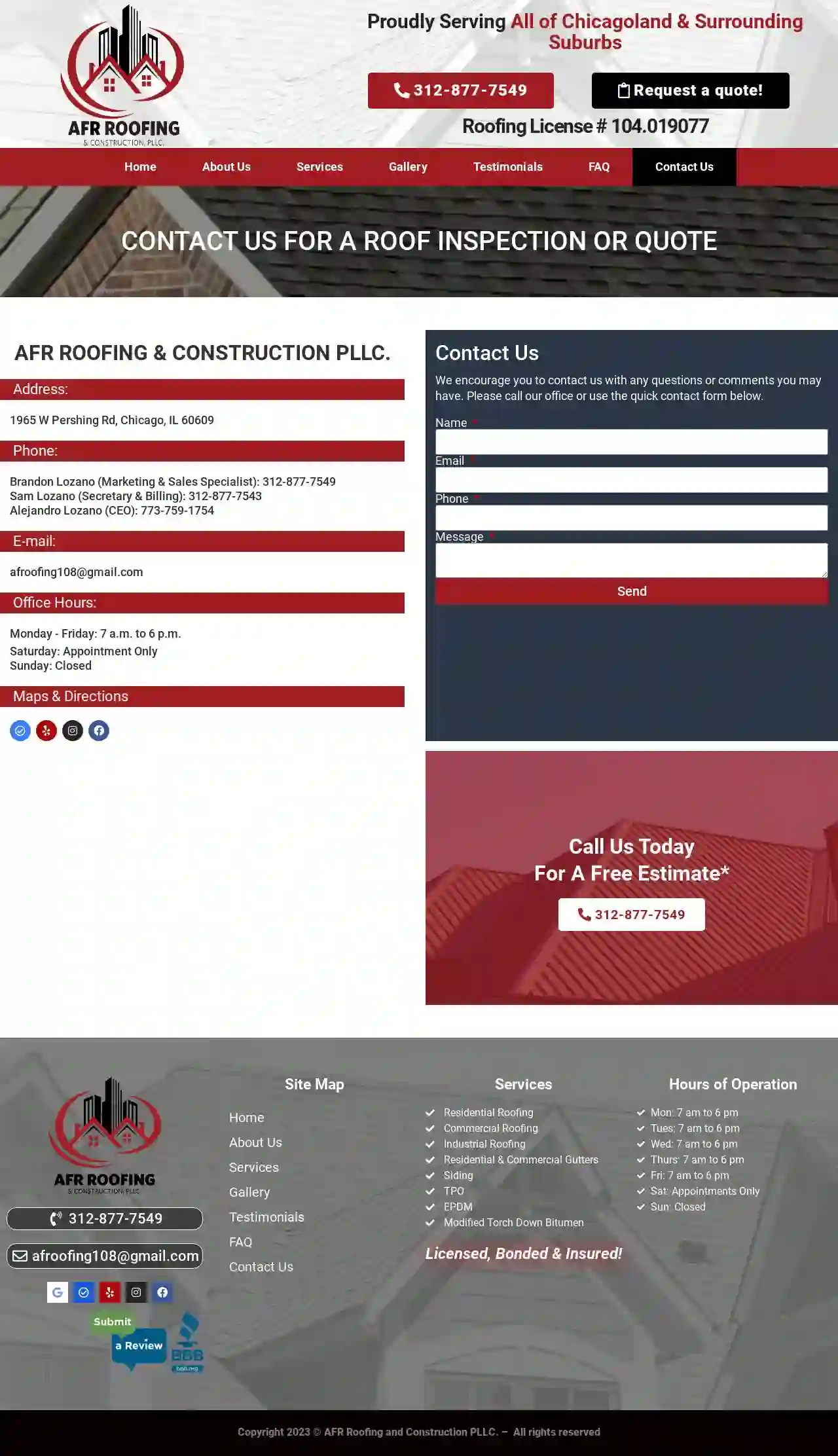
AFR Roofing & Construction PLLC.
56 reviews1965 W Pershing Rd, Chicago, 60609, USAFR Roofing & Construction is a professional roofing company serving the Chicagoland area for over 30 years. We understand that hiring a roofing contractor can be a daunting task, but we take pride in every installation and stand behind our work with a rock-solid warranty. Our team of experienced professionals uses only the highest quality materials and best practices to ensure a quality installation that will look great and provide the functionality you desire. We are fully insured and locally owned, making us the perfect choice for your next roofing project.
- Services
- Why Us?
- Our Team
- Testimonials
- Gallery
Get Quote
Cramer Siding & Window
3.652 reviewsChampaign, USCramer Siding & Window: Champaign Siding, Windows, and More. The Time-Tested Siding & Window Company Providing Home Improvement Since 1955. Save 10% on your new deck, patio or sunroom! Get your free estimate today. (217) 655-4496 Free Estimate. The Best in Siding, Windows, Roofing, Doors, Outdoor Living & Sunrooms in Champaign-Urbana.
- Services
- Why Us?
- Gallery
Get Quote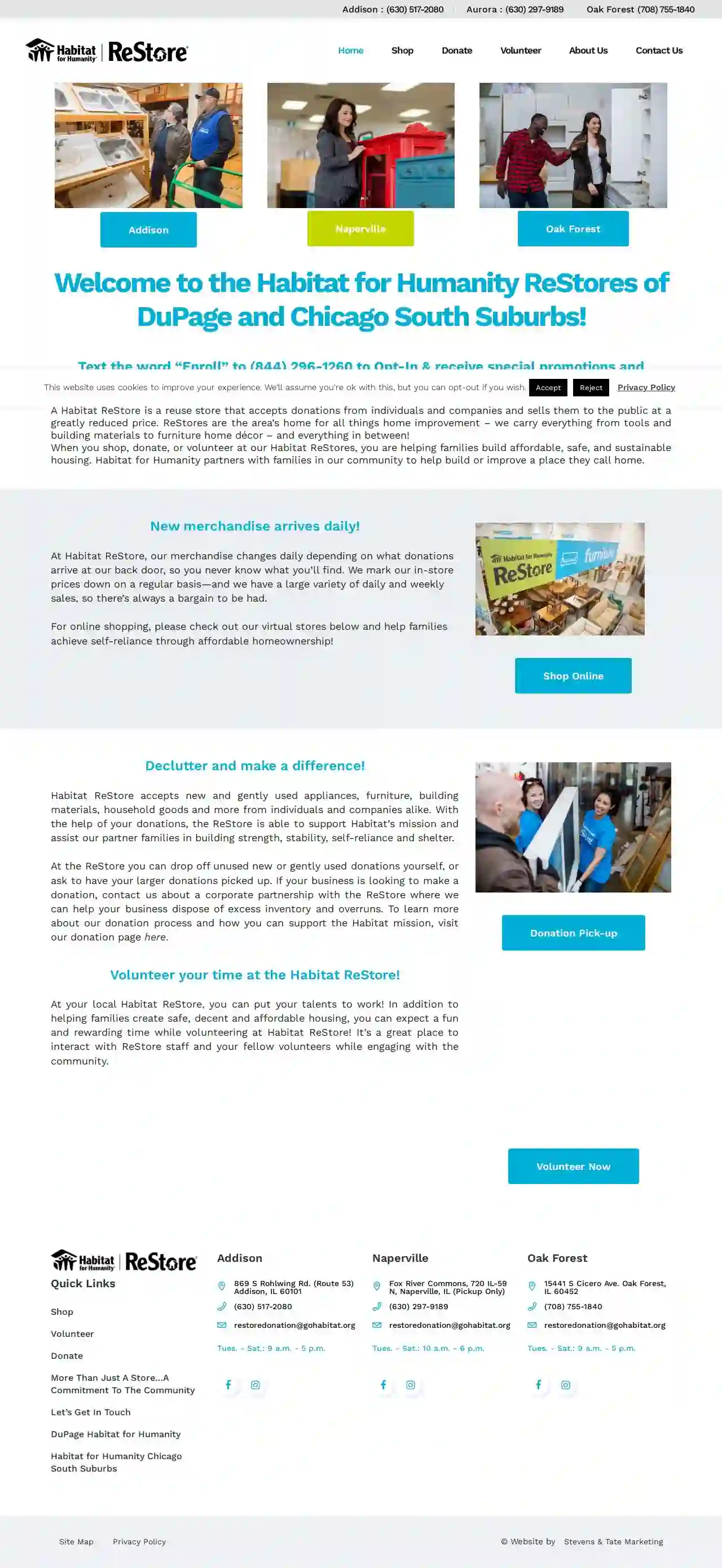
DuPage County ReStore at Fox Valley Mall
4390 reviews869 S Rohlwing Rd., (Route 53), 869 S Rohlwing Rd. (Route 53), Addison, 60101, USHabitat for Humanity ReStores of DuPage and Chicago South Suburbs is a network of reuse stores that accept donations from individuals and companies and sell them to the public at a greatly reduced price. We carry everything from tools and building materials to furniture and home décor. When you shop, donate, or volunteer at our Habitat ReStores, you are helping families build affordable, safe, and sustainable housing. Habitat for Humanity partners with families in our community to help build or improve a place they call home. New merchandise arrives daily at our stores, so you never know what you’ll find. We mark our in-store prices down on a regular basis—and we have a large variety of daily and weekly sales, so there’s always a bargain to be had. For online shopping, please check out our virtual stores below and help families achieve self-reliance through affordable homeownership! Habitat ReStore accepts new and gently used appliances, furniture, building materials, household goods and more from individuals and companies alike. With the help of your donations, the ReStore is able to support Habitat’s mission and assist our partner families in building strength, stability, self-reliance and shelter. At the ReStore you can drop off unused new or gently used donations yourself, or ask to have your larger donations picked up. If your business is looking to make a donation, contact us about a corporate partnership with the ReStore where we can help your business dispose of excess inventory and overruns. To learn more about our donation process and how you can support the Habitat mission, visit our donation page here. At your local Habitat ReStore, you can put your talents to work! In addition to helping families create safe, decent and affordable housing, you can expect a fun and rewarding time while volunteering at Habitat ReStore! It’s a great place to interact with ReStore staff and your fellow volunteers while engaging with the community.
- Services
- Why Us?
- Gallery
Get Quote
ACA Roofing & Construction
4.317 reviewsChicago, USACA Roofing Companies Chicago is a top roofing company operating in the whole Chicagoland. We are proud to offer our clients the best roofing solutions. Each of our contractors has years of experience in roof installation, roof replacement and re-roofing. Since its inception, ACA Roofing Companies have been expanding and currently covers a wider range of services. No matter what type of roof you have, our roofing contractors can do the job! Contact us today for a FREE ESTIMATE! ACA Roofing Companies is the preferred choice for all the roof installation and repair needs! We are an accredited Chicago Roofing Company. The roofing contractors at ACA have years of glowing reviews from satisfied customers. When it comes to roofing companies in the Chicago area, ACA Roofing is at the top of the list. Please check out our amazing reviews on Angie’s List! Roofing contractors hired by us are extremely reliable. At the same time, our customer service is always friendly and ready to help, but never fails to meet the customers’ expectations and needs. While covering a wide range of roofing services – from repairs to new installations - we also perform it at the highest quality! Our crew has years of experience. All of that, makes us the best possible roofing company in Chicago! The customers’ satisfaction is our priority and we are always friendly and available. Completing the jobs as quickly and efficiently as possible, hence ACA is the complete package! We offer our services at very competitive rates. Knowing that choosing a company to do your roof is a stressful endeavor, we want to make you feel at ease when working with us. Our contractors do not expect you to be the expert, that’s our job. Therefore, we will always give you honest estimates and precise timeframes, offering complete transparency throughout the process. Interested in hiring ACA Roofing? Call today!
- Services
- Why Us?
- Accreditations
- Gallery
Get Quote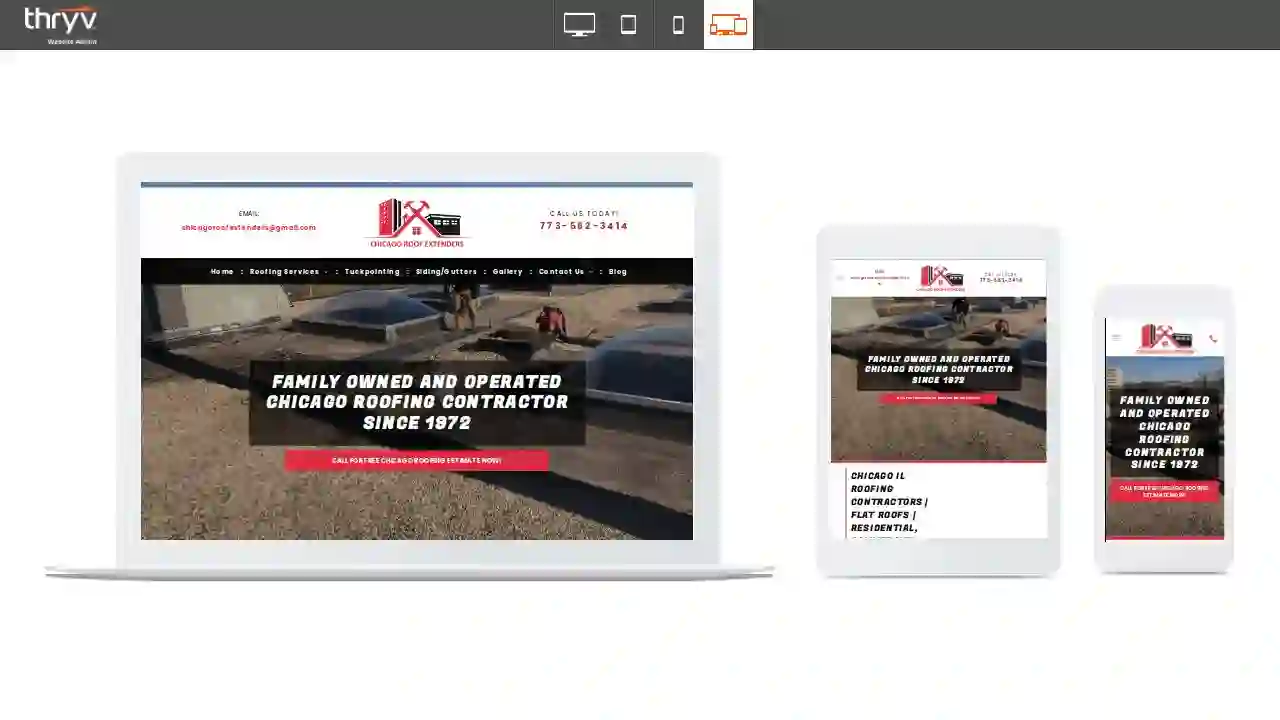
Chicago Roof Extenders
54 reviews1000 W. Fullerton Ave., Suite 200, Chicago, 60630, USChicago Roof Extender is a family-owned and operated business serving the Chicago area for over 20 years. We specialize in extending existing roofs to provide additional living space. Our team of experienced professionals is dedicated to providing high-quality workmanship and exceptional customer service. We use only the finest materials and the latest techniques to ensure that your roof extension is both beautiful and durable. Whether you're looking to add a sunroom, a master suite, or simply more living space, Chicago Roof Extender can help you achieve your goals. We offer a wide range of services, including: Roof Extensions Roof Repairs Roof Replacements Siding Gutters Contact us today for a free consultation.
- Services
- Why Us?
Get Quote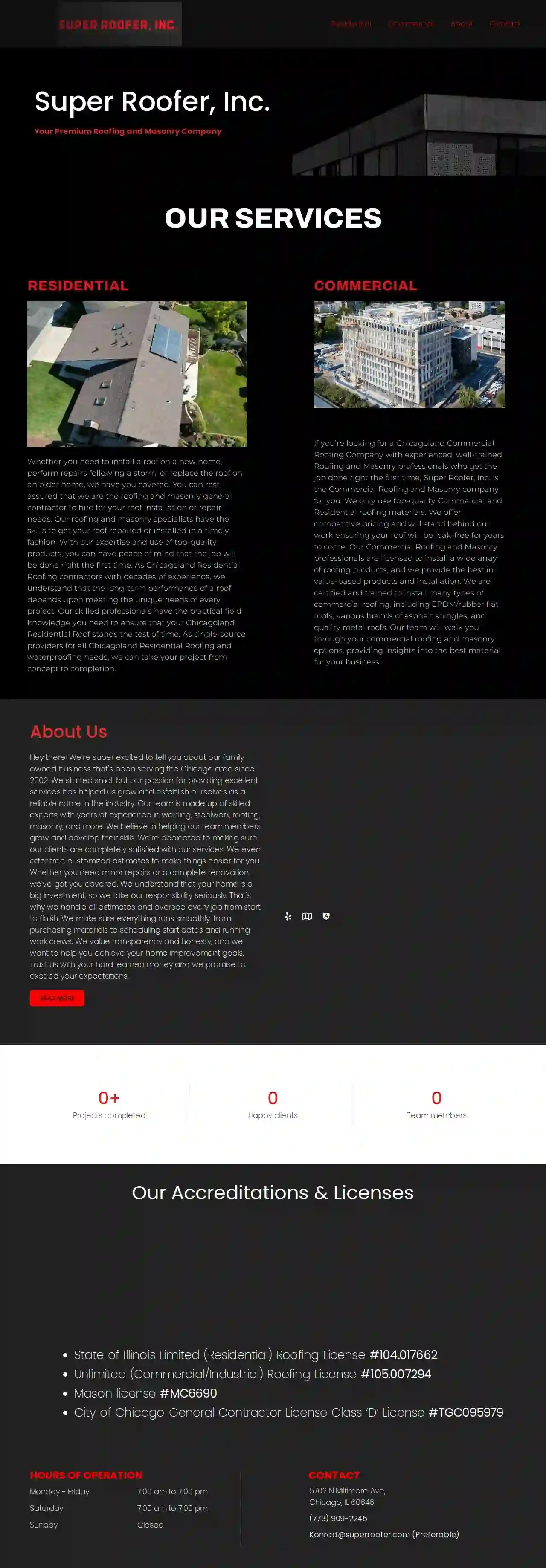
Super Roofer, Inc.
57 reviews5702 N Miltimore Ave, Chicago, 60646, USWhether you need to install a roof on a new home, perform repairs following a storm, or replace the roof on an older home, we have you covered. You can rest assured that we are the roofing and masonry general contractor to hire for your roof installation or repair needs. Our roofing and masonry specialists have the skills to get your roof repaired or installed in a timely fashion. With our expertise and use of top-quality products, you can have peace of mind that the job will be done right the first time. As Chicagoland Residential Roofing contractors with decades of experience, we understand that the long-term performance of a roof depends upon meeting the unique needs of every project. Our skilled professionals have the practical field knowledge you need to ensure that your Chicagoland Residential Roof stands the test of time. As single-source providers for all Chicagoland Residential Roofing and waterproofing needs, we can take your project from concept to completion. If you’re looking for a Chicagoland Commercial Roofing Company with experienced, well-trained Roofing and Masonry professionals who get the job done right the first time, Super Roofer, Inc. is the Commercial Roofing and Masonry company for you. We only use top-quality Commercial and Residential roofing materials. We offer competitive pricing and will stand behind our work ensuring your roof will be leak-free for years to come. Our Commercial Roofing and Masonry professionals are licensed to install a wide array of roofing products, and we provide the best in value-based products and installation. We are certified and trained to install many types of commercial roofing, including EPDM/rubber flat roofs, various brands of asphalt shingles, and quality metal roofs. Our team will walk you through your commercial roofing and masonry options, providing insights into the best material for your business. Hey there! We're super excited to tell you about our family-owned business that's been serving the Chicago area since 2002. We started small but our passion for providing excellent services has helped us grow and establish ourselves as a reliable name in the industry. Our team is made up of skilled experts with years of experience in welding, steelwork, roofing, masonry, and more. We believe in helping our team members grow and develop their skills. We're dedicated to making sure our clients are completely satisfied with our services. We even offer free customized estimates to make things easier for you. Whether you need minor repairs or a complete renovation, we've got you covered. We understand that your home is a big investment, so we take our responsibility seriously. That's why we handle all estimates and oversee every job from start to finish. We make sure everything runs smoothly, from purchasing materials to scheduling start dates and running work crews. We value transparency and honesty, and we want to help you achieve your home improvement goals. Trust us with your hard-earned money and we promise to exceed your expectations.
- Services
- Why Us?
- Accreditations
- Gallery
Get Quote
H&H Roofing, Inc.
4.944 reviewsChicago, USH & H Roofing is a family owned and operated business. We offer FREE estimates on replacement roofing services. Roofing License Contractors #104-018593.
- Services
- Why Us?
- Gallery
Get Quote
Over 17,196+ Roofing Companies onboarded
Our roofing pros operate in Wonder Lake and beyond!
Roofyng.com has curated and vetted Top Roofing Companies arround Wonder Lake. Find a top & reliable pro today.
Frequently Asked Questions About Roofing Companies
- Experience: Companies with a solid track record and years of experience in the industry.
- Licensing and Insurance: Verify they are properly licensed to operate in your area and carry adequate insurance to protect you from liability.
- Certifications: Look for certifications from reputable organizations, demonstrating expertise in specific roofing materials or techniques.
- Positive Reviews: Check online reviews and testimonials from previous customers.
- Professionalism: Choose a company that communicates clearly, provides detailed estimates, and has a courteous and responsive team.
- Choose Reflective Roofing Materials: Opt for light-colored shingles or metal roofing that reflects sunlight and reduces heat absorption.
- Install Proper Attic Insulation: Adequate insulation prevents heat loss in the winter and heat gain in the summer.
- Ensure Adequate Ventilation: Proper attic ventilation allows hot air to escape, reducing cooling costs and extending the lifespan of your roof.
- Consider a Radiant Barrier: In hot climates, a radiant barrier installed in the attic can reflect heat away from the roof, further reducing cooling needs.
What is the difference between a roof overlay and a roof tear-off?
Roof Overlay: Installing a new layer of roofing material over the existing roof. It's less expensive and faster, but not always ideal.
Roof Tear-Off: Completely removing the existing roofing before installing a new one. More labor-intensive but allows for inspection and repairs to the roof deck.
A tear-off is typically preferred, but a roofing contractor can advise on the best approach for your situation.
How do I find a good roofing company?
What is a roof valley, and why is it important?
How can I make my new roof more energy-efficient?
What is the difference between a roof overlay and a roof tear-off?
Roof Overlay: Installing a new layer of roofing material over the existing roof. It's less expensive and faster, but not always ideal.
Roof Tear-Off: Completely removing the existing roofing before installing a new one. More labor-intensive but allows for inspection and repairs to the roof deck.
A tear-off is typically preferred, but a roofing contractor can advise on the best approach for your situation.
How do I find a good roofing company?
- Experience: Companies with a solid track record and years of experience in the industry.
- Licensing and Insurance: Verify they are properly licensed to operate in your area and carry adequate insurance to protect you from liability.
- Certifications: Look for certifications from reputable organizations, demonstrating expertise in specific roofing materials or techniques.
- Positive Reviews: Check online reviews and testimonials from previous customers.
- Professionalism: Choose a company that communicates clearly, provides detailed estimates, and has a courteous and responsive team.
What is a roof valley, and why is it important?
How can I make my new roof more energy-efficient?
- Choose Reflective Roofing Materials: Opt for light-colored shingles or metal roofing that reflects sunlight and reduces heat absorption.
- Install Proper Attic Insulation: Adequate insulation prevents heat loss in the winter and heat gain in the summer.
- Ensure Adequate Ventilation: Proper attic ventilation allows hot air to escape, reducing cooling costs and extending the lifespan of your roof.
- Consider a Radiant Barrier: In hot climates, a radiant barrier installed in the attic can reflect heat away from the roof, further reducing cooling needs.